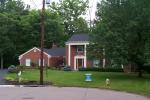Search engine visitors - click here to access entire "$ensible Home" web site
Click here to see a descriptive illustration showing an actual landscaping layout and a schematic layout.
Dear Jim: My parent's yard has trees and their air conditioner seems to run less than ours. I know it takes years for trees to grow, but can you give me some tips on where and what kind to plant in our yard? - Sandra H.

A: It is not just your imagination your parent's air conditioner runs less because of having trees in their yard. The Department of Energy (DOE) has done sophisticated computer models showing just three properly placed trees can cut your utility bills by up to $250 per year.
There are many other benefits from landscaping your yard with the proper type and placement of trees. By shading your house, the walls, shingles, even curtains indoors, will last longer because the sun's rays are blocked. The air immediately around your home will be less polluted and the oxygen level will be higher. Trees also create a sound barrier from road noise.
People often think of shading as the primary cooling effect, but trees also function as natural air conditioners through a evapotranspiration process. As the leaves on trees give off water, they cool the air similarly to how our own perspiration cools our skin. The air temperature near the house on a well-landscaped yard can be 10 degrees cooler than on a treeless one.
The key to efficient landscaping is selecting the proper species and placing them in the proper location for your specific climate. A well-landscaped yard in the hot, dry Southwest will look totally different from one in humid Georgia or in the Plains. Draw a layout of your yard and decide where you need trees for your climate type. Also determine the height, shape, type (evergreen or deciduous), and growth rate of the trees. Next, talk with a local garden store expert to make sure you are planting trees which will thrive in your climate zone.
In a temperate climate, you will also be concerned about winter heating bills. Plant deciduous trees on south and west leaving a small gap to the southwest for breezes. During winter with the leaves down, the sun will shine through. Plant evergreens on the north side for a winter windbreak.
In a hot, humid climate, you air condition more often. Natural breezes are good, but not as important as in a temperate climate. Shading is most important with tall trees to the south side. Avoid an overabundance of plantings which will raise the humidity level and reduce the cooling effect.
In hot, dry climates, planting trees to shade the walls and roof is critical. Tall trees with a high canopy are effective. Lower plantings placed near the house are good because, with the dry air, the evapotranspiration process can create significant cooling.
Instant Download Update Bulletin No. 438 - a selector guide of 100 types (deciduous and evergreen) of trees, mature heights and shapes, growth rates (slow, moderate or fast), hardiness zones and recommended landscape layouts with illustrations for the various climates - hot/humid climate, hot/arid climate, cool climate and temperate climate; schedule for tree care, planting and caring tips for trees.
Dear Jim: I noticed damp spots on the ceiling below the second-floor bathroom. They are directly under the toilet. I have checked and the toilet is not leaking or running. What is the source of the spots? - John K.
A: There can be many sources for the spots because water will run along joists and drip off the lowest point often far from the source. Since they are under the toilet, that is the first possible source to check.
Most likely, the wax ring, where the toilet rests over the drain pipe, is leaky. This will happen over time, especially if the toilet is not bolted tightly to the floor. Replace the wax ring and see if that fixes the problem.